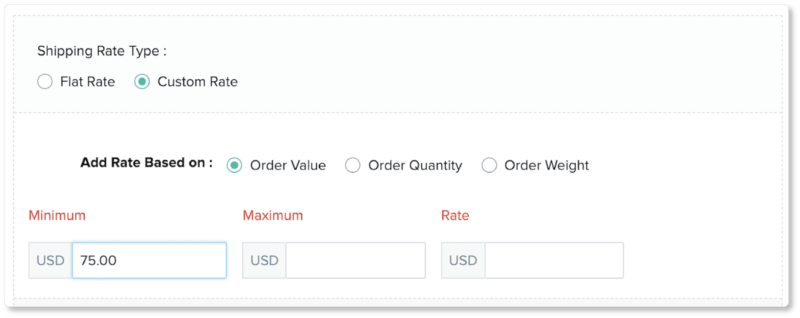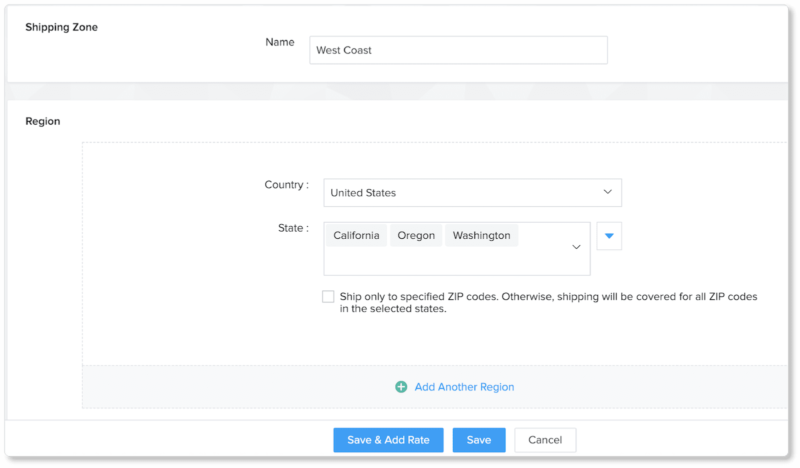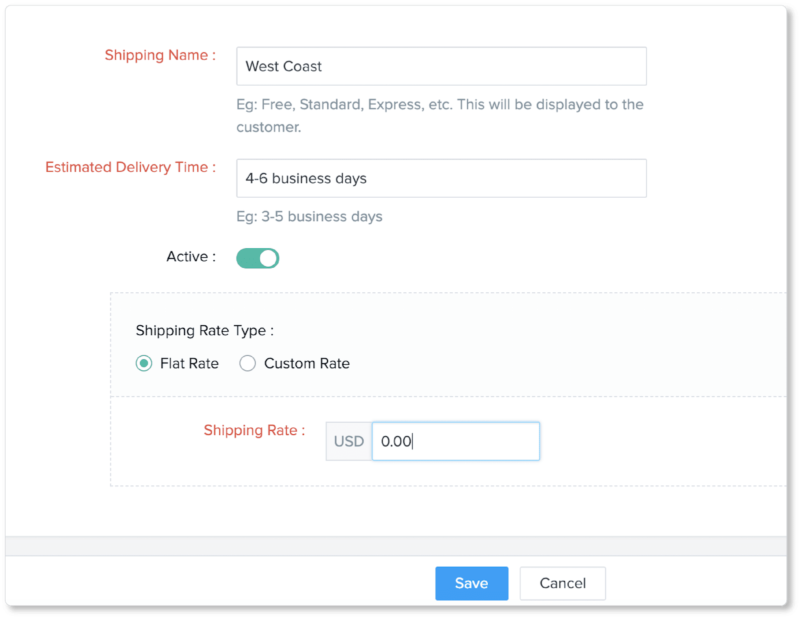- HOME
- Ecommerce
- Building Your Ecommerce Website
- Deciding What to Charge Your Customers for Shipping
Deciding What to Charge Your Customers for Shipping
- 10 Mins Read
- Posted on March 8, 2019
- Last Updated on October 8, 2024
- By Lauren
In the last section, we led you through the process of determining the best payment gateway for your business so customers can pay you for your products. Now we’ll discuss the other side of that coin: How to get your products into your customers’ hands. After all, you won’t get to watch customers walk out of your store, so you’ll want to feel confident that their ecommerce purchase will ship to them as safely, seamlessly, and inexpensively (for both of you) as possible.
Shipping prices and delivery strategies are crucial to get right; and they require that you make quite a few decisions along the way: what carriers you’ll use, what service levels you’ll offer, where you’re willing to ship to, and how you’ll pass shipping costs on to your customer. (We’ll show you how to determine your ecommerce carrier in the next section. For now, we’ll focus on pricing options.) There’s a lot happening behind the scenes; and shipping is hands-down the biggest expense ecommerce businesses have to contend with.
The “best” shipping strategy for your business has three characteristics: 1) It’s priced low enough that your customers are willing to pay for it; 2) It’s priced high enough that you can cover your costs; and 3) It offers customers the options they want—both economy and speed. Indeed, studies continue to show that shipping costs are the #1 reason for cart abandonment; at the same time, 87% of customers said shipping speed was a key factor in whether they’d do business with an online shop again. Of course, this would seem to put you in a double bind.
So is there such a thing as “shipping best practices”? Is it possible to craft a shipping strategy that makes your customers happy (for both its cost and its speed) and that doesn’t cut too deeply into your margins? Below, we’ll discuss your options for setting shipping rates, along with recommendations for which pricing structure will work best for your products. And if you read this section and the next one, we think you’ll find the answers to both of those questions is “yes.”
Pricing Strategies for Shipping and Handling
We don’t have to tell you that shipping and handling fees are often the deal-breaker for customers. You’ve certainly been on the other side of the transaction, wavering on a purchase in the midst of “sticker shock.” You know from experience that there’s a “sweet spot” for every product that hinges on any number of factors. In a moment, we’ll discuss the most popular strategies for shipping prices. Our advice is to keep three things in mind as you read:
1) Your customers. Where are the majority of them located (national/international, urban/rural)? How much are they willing to pay for shipping? Are they price sensitive? What pricing strategy will keep them coming back? What’s the average lifetime value of your customers? Factor the likelihood of repeat purchases into your equation!
2) Your product. How expensive/big/heavy is it? Do customers typically need it right away, or is it something they’re willing to wait for? What’s your average order value; and what’s your margin on that value? Further, does your product have a high return rate? (Apparel, for example, tends to have a higher return rate than personal care products do.) You might need to mark up shipping costs on items that tend to be returned more often.
3) Your competition. How competitive is your industry or niche? What are your competitors’ pricing strategies? If you sell handmade items that can’t be found anywhere else, consumers will be more willing to pay for shipping than they will for products that can be found in a hundred other online shops.
Option 1: Offer free shipping
Naturally, this is the most attractive option for your customers, most of whom—in the age of Amazon—have come to expect it. It’s also great for your marketing: Displaying a “Free Shipping” banner on your homepage and product pages is sure to get prospects’ attention and boost your conversion rates. After all, it removes a major psychological barrier. Indeed, 80% of shoppers say free shipping is the primary incentive that would prompt them to shop online more often. That’s a number worth taking seriously.
But before you dive in and start promoting free shipping all over your site, consider your numbers (or your projected numbers): average order value; the costs of packaging, shipping, warehousing and fulfillment (if you’re using these); labor; and so on. Even Amazon only offers free shipping on purchases over $25. They have to attend to these numbers, too.
Now, we know what you’re thinking: From a numbers perspective, free shipping looks impossible to offer. But businesses have gotten around having to fully absorb shipping costs themselves in a variety of ways, including:
Limiting free shipping to certain regions
If you’re in the U.S., for example, maybe you only offer free shipping to the 48 contiguous states. Alaska, Hawaii, Puerto Rico, and other countries will have to pay. (Don’t worry, they’ll expect it!) This way, you’re not losing money on every order. If you’re using Zoho Commerce, you can easily set regions by going into the “Zones” module, choosing your country and states (or provinces), and setting the “Flat Rate” to $0:
Limiting free shipping to particular products
This is a great strategy for retailers who offer a wide range of products. It allows you to offer free shipping only on those products whose costs you can reasonably absorb (typically the expensive, smaller, or more lightweight ones). You can also use this strategy to move old stock, to get a “featured product” in front of more customers, or to encourage customers to buy those higher-margin products that do allow you to ship for free. If you choose this route, make sure to shout out “Free Shipping” on those respective product pages.
Setting a minimum order value
Remember, this is Amazon’s strategy: “Free shipping on orders over $25.” Setting a minimum order value encourages shoppers to spend more, driving up your average order value. Indeed, 48% of online shoppers have added items to their carts in order to qualify for free shipping.
Pro tip: If you’re already in business, use your current average order value to determine the minimum order value for free shipping by rounding up a bit. If your average order value is $65, test a free shipping offer with a $75-or-more purchase. This way you can be sure you’re actually increasing sales:

Offering free shipping to your most loyal customers
A loyalty program is never a bad idea. After all, customers who get free shipping on all their purchases with you are likely to buy more over time. So consider customer lifetime value (CLV). Depending on your commerce platform, this will be done in different ways.
Increasing your product price to cover the cost of free shipping
We all know that free shipping is, to some extent, psychological—meaning consumers prefer to pay more for a product if it means free shipping, even if the total dollar amount is exactly the same in the end. So consider building the shipping costs into the list price. This way, customers are technically paying for the shipping, even though it feels “free.”
Offering free shipping… but setting the delivery date out a bit longer than the average shopper is willing to wait
You’ll want to experiment with pricing and delivery dates to determine customer thresholds, of course; but there might be a “sweet spot” in which half your customers “upgrade” to the next shipping option, paying to have the item sooner. You can then feel better offering free shipping to the 50% of customers who don’t choose that option.
Free shipping is generally best for items that are not luxury or handmade (customers are willing to pay extra for these things), that are small and lightweight, that have high profit margins, and that exist in a competitive market in which free shipping is already the norm.
Option 2: Offer flat rates or table-based shipping
A flat rate (also known as a fixed rate) is just what it sounds like: charging the same rate for all orders, regardless of package weight, value, or size. As you can probably imagine, this strategy works best for businesses whose products are of similar size and weight. Otherwise, customers who order smaller, lighter products will bear the brunt of the costs for customers who order bigger, heavier products.
The benefits of flat rate shipping are that it’s easy to communicate, easy for consumers to understand, and—assuming you put your flat-rate price on your homepage—no one will experience sticker shock during checkout. It also encourages larger orders, since shipping price doesn’t go up as the number of contents in the cart increases. Of course, you’ll win and lose on certain orders, so you’ll want to choose a flat rate price that lets you break even. The work will be in calculating the average shipping cost per package—something you should regularly be doing anyway to ensure you’re not over- or under-charging your customers.
If you don’t have a sense of “average shipping cost” yet, you can guesstimate by taking your product measurements and entering them into your shipping carrier’s calculator (we’ll show you how in the next section), along with various destination locations where your target market is. Then estimate which products will sell more. After entering many combinations, you’ll start to see trends develop that point to your average cost.
Of course, you can get creative with your “flat rates”: $4 for the first product and $2 for each additional product, for example. You can also pair flat rates with free shipping: free shipping on all orders over $50; a $4.95 flat rate on all orders under $50. And so on.
Table-based (or table rate) shipping assigns a series of flat rates to orders, based on the characteristics of the order (subtotal, quantity, weight) or the destination. Maybe shipping costs decrease as the total order value increases (this is called “price-based shipping”). Maybe shipping costs increase as the distance between the warehouse or fulfillment center and the destination increases. This strategy makes sense for businesses that offer products of a variety of sizes and weights, and/or that ship internationally. After all, if you’re based in San Francisco, your customers in Los Angeles shouldn’t be paying as much for shipping as your customers in Shanghai are.
Option 3: Offer real-time shipping quotes
A third option is to calculate shipping costs on a per-order basis. The major shipping carriers all offer rate calculators on their websites. They also have APIs that connect with commerce platforms, allowing the store to calculate shipping rates on the fly based on product size and weight, origination and destination locations. When the customer enters their destination address and shipping method into the checkout forms (or better, into a calculator on the product page), the API pulls live rates from the carrier.
The benefit of this strategy is—at least in theory—that you won’t over- or under-charge your customers, because they’ll be paying exactly what you would pay for shipping… plus you’ll earn trust points for transparency. It’s also great for international shipments, since costs can vary significantly between countries. Then again, API’s don’t always pick up additional costs like surcharges. What’s more, things can get complicated when customers try to purchase multiple items that can be packaged together. The calculator doesn’t necessarily know to reduce the number of boxes and offers a higher shipping price, spurring cart abandonment.
Of course, cart abandonment is your biggest risk with this strategy, given customers won’t know the full shipping costs until checkout—which nearly always results in surprises. So we’d only suggest offering real-time quotes in limited situations: if your products are expensive and lightweight, for example, meaning the cost of shipping will amount to just a small percentage of the order total. Or if you sell the same product as your competitors, and so you need to compete on shipping price.
Option 4: Offer a combination of these strategies
Market research and trial-and-error might suggest to you that a combinatory strategy is your best bet. Offering different minimum order values for domestic and international purchases, for instance; or offering real-time quotes to your prospects, but 40% off those quotes to customers in your loyalty program. Our point is to think outside the box. It will take some patience and some attention. Test a few strategies and use analytics to track losses, changes in order value averages, cart abandonment rates, and so on. In time, you’ll hit upon a balance that makes sense for everyone involved.
Up-Front v. Calculated Shipping Rates
Each of the pricing options we mentioned above falls into one of two categories: It’s either an up-front or a calculated shipping rate. In the former (free shipping, flat rates), all psychological hurdles have been cleared by the time a prospect gets to checkout. In the latter, on the other hand (real-time quotes, weight- and price-based methods), the costs can’t be calculated until the platform knows exactly what’s being purchased and where it’s being shipped. So you’re essentially asking the customer to decide for a second time if the price is worth the product. It introduces an obstacle in the final stage.
That said, if you must go the route of calculated shipping, set expectations as early as possible—ideally before customers even add products to their cart. Communicate estimated shipping costs on your homepage, or offer a shipping calculator on your product pages. This way, prospects have some sense of what they’ll be paying for shipping before they even put the product in the cart. Remember, in 2018 55% of online shoppers cited unexpected costs as a reason for abandoning a cart. So choose transparency and forthrightness—no matter what your shipping prices look like.
You’ve got a sense of your pricing options now; and perhaps you’re already leaning toward a “best option” based on your products, your location, your reach, and your customers. But you can’t fully commit until you have a sense of what carriers will charge to ship your products. In the next section, we’ll walk you through the second half of “The Delivery Fee Decision”: how to estimate shipping costs and choose a carrier for your ecommerce store.

